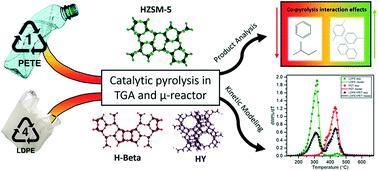当前位置:
X-MOL 学术
›
React. Chem. Eng.
›
论文详情
Our official English website, www.x-mol.net, welcomes your
feedback! (Note: you will need to create a separate account there.)
Catalytic co-pyrolysis of LDPE and PET with HZSM-5, H-beta, and HY: experiments and kinetic modelling
Reaction Chemistry & Engineering ( IF 3.4 ) Pub Date : 2022-06-30 , DOI: 10.1039/d2re00144f Sean Timothy Okonsky 1 , J. V. Jayarama Krishna 2 , Hilal Ezgi Toraman 1, 2, 3
Reaction Chemistry & Engineering ( IF 3.4 ) Pub Date : 2022-06-30 , DOI: 10.1039/d2re00144f Sean Timothy Okonsky 1 , J. V. Jayarama Krishna 2 , Hilal Ezgi Toraman 1, 2, 3
Affiliation

|
In this study, the catalytic pyrolysis of low-density polyethylene (LDPE), polyethylene terephthalate (PET) and their mixture (1 : 1 wt/wt) with three zeolite catalysts (HZSM-5, H-beta, HY) was investigated using a thermogravimetric analyzer (TGA) and a Pyroprobe® micro-reactor coupled to a gas chromatograph mass spectrometer (Py-GC/MS). The TGA results demonstrated that during pyrolysis at 10 °C min−1, on average, zeolite catalysts decreased the maximum decomposition temperature by 149 °C for LDPE while only decreasing by 8 °C for PET. The derivative thermogravimetric (DTG) curve evidenced interactions when the two polymers were catalytically co-pyrolyzed for all the three catalysts. A lumped nth order reaction scheme was able to accurately model both non-catalytic and catalytic pyrolysis and co-pyrolysis by using the least squares fitting approach for determining the kinetic parameters. The kinetic model was able to model well the interaction effects observed during catalytic co-pyrolysis of LDPE and PET with HZSM-5, H-beta, and HY (Fit%Wt% > 96%, Fit%DTG > 94%). Py-GC/MS experiments for the catalytic fast pyrolysis of LDPE revealed that HZSM-5 resulted in the highest selectivity to aromatic hydrocarbons (31.6%) and HY resulted in the highest selectivity to gasoline range C5–C10 paraffins and olefins (40.9%). Catalytic fast pyrolysis of PET showed high selectivity to benzene for all the catalysts (>43%) and that HZSM-5 resulted in the highest selectivity to polyaromatic hydrocarbons (24.7%). The catalytic fast co-pyrolysis of LDPE and PET revealed interaction effects for all the three catalysts evidenced by a positive synergy% for alkylated benzenes (3–142%) and polyaromatics (105–187%) with a concomitant negative synergy% for benzene (24–36%) and C5–C10 paraffins and olefins (27–53%).
中文翻译:

LDPE 和 PET 与 HZSM-5、H-β 和 HY 的催化共热解:实验和动力学建模
在这项研究中,研究了低密度聚乙烯 (LDPE)、聚对苯二甲酸乙二醇酯 (PET) 及其混合物 (1:1 wt/wt) 与三种沸石催化剂 (HZSM-5, H-beta, HY) 的催化热解。热重分析仪 (TGA) 和与气相色谱质谱仪 (Py-GC/MS) 耦合的 Pyroprobe® 微反应器。TGA 结果表明,在 10 °C min -1的热解过程中,沸石催化剂平均将 LDPE 的最大分解温度降低了 149 °C,而 PET 仅降低了 8 °C。当两种聚合物对所有三种催化剂进行催化共热解时,导数热重 (DTG) 曲线证明了相互作用。集总n通过使用最小二乘拟合方法确定动力学参数,三级反应方案能够准确地模拟非催化和催化热解和共热解。动力学模型能够很好地模拟 LDPE 和 PET 与 HZSM-5、H-β 和 HY 的催化共热解过程中观察到的相互作用效应(Fit% Wt% > 96%,Fit% DTG > 94%)。LDPE 催化快速裂解的 Py-GC/MS 实验表明,HZSM-5 对芳烃的选择性最高 (31.6%),HY 对汽油范围 C 5 –C 10的选择性最高石蜡和烯烃(40.9%)。PET 的催化快速热解对所有催化剂都显示出对苯的高选择性 (>43%),而 HZSM-5 对多环芳烃的选择性最高 (24.7%)。LDPE 和 PET 的催化快速共热解揭示了所有三种催化剂的相互作用效应,烷基化苯 (3-142%) 和多环芳烃 (105-187%) 具有正协同作用%,同时对苯具有负协同作用% ( 24–36%) 和 C 5 –C 10链烷烃和烯烃 (27–53%)。
更新日期:2022-06-30
中文翻译:

LDPE 和 PET 与 HZSM-5、H-β 和 HY 的催化共热解:实验和动力学建模
在这项研究中,研究了低密度聚乙烯 (LDPE)、聚对苯二甲酸乙二醇酯 (PET) 及其混合物 (1:1 wt/wt) 与三种沸石催化剂 (HZSM-5, H-beta, HY) 的催化热解。热重分析仪 (TGA) 和与气相色谱质谱仪 (Py-GC/MS) 耦合的 Pyroprobe® 微反应器。TGA 结果表明,在 10 °C min -1的热解过程中,沸石催化剂平均将 LDPE 的最大分解温度降低了 149 °C,而 PET 仅降低了 8 °C。当两种聚合物对所有三种催化剂进行催化共热解时,导数热重 (DTG) 曲线证明了相互作用。集总n通过使用最小二乘拟合方法确定动力学参数,三级反应方案能够准确地模拟非催化和催化热解和共热解。动力学模型能够很好地模拟 LDPE 和 PET 与 HZSM-5、H-β 和 HY 的催化共热解过程中观察到的相互作用效应(Fit% Wt% > 96%,Fit% DTG > 94%)。LDPE 催化快速裂解的 Py-GC/MS 实验表明,HZSM-5 对芳烃的选择性最高 (31.6%),HY 对汽油范围 C 5 –C 10的选择性最高石蜡和烯烃(40.9%)。PET 的催化快速热解对所有催化剂都显示出对苯的高选择性 (>43%),而 HZSM-5 对多环芳烃的选择性最高 (24.7%)。LDPE 和 PET 的催化快速共热解揭示了所有三种催化剂的相互作用效应,烷基化苯 (3-142%) 和多环芳烃 (105-187%) 具有正协同作用%,同时对苯具有负协同作用% ( 24–36%) 和 C 5 –C 10链烷烃和烯烃 (27–53%)。











































 京公网安备 11010802027423号
京公网安备 11010802027423号